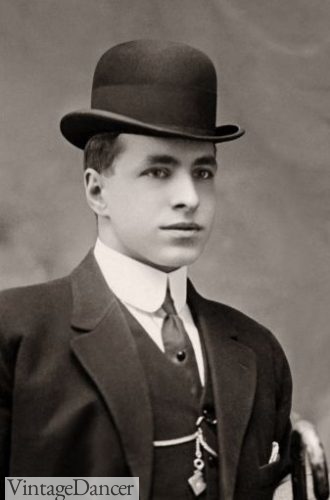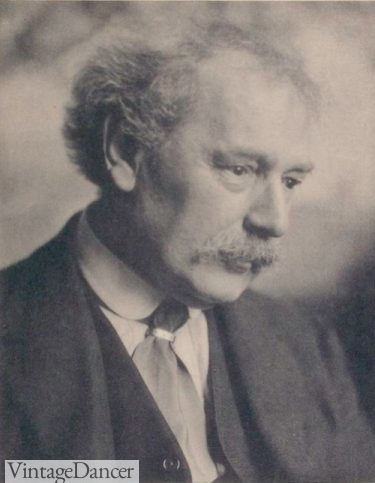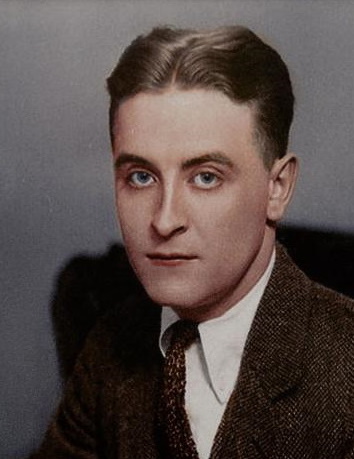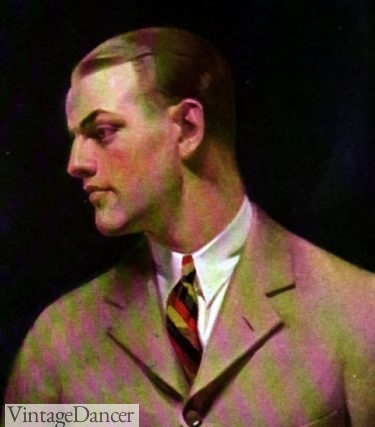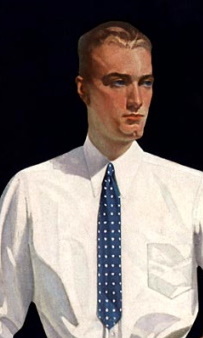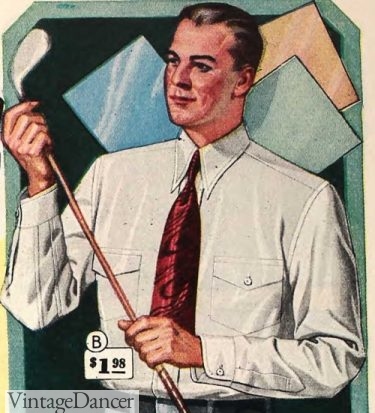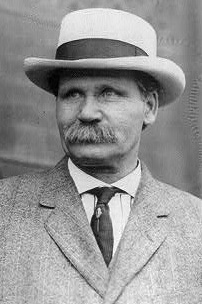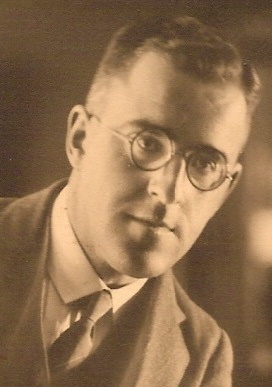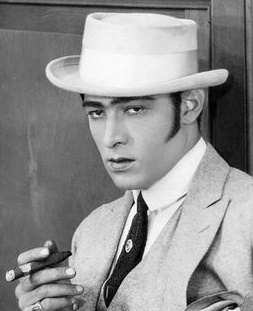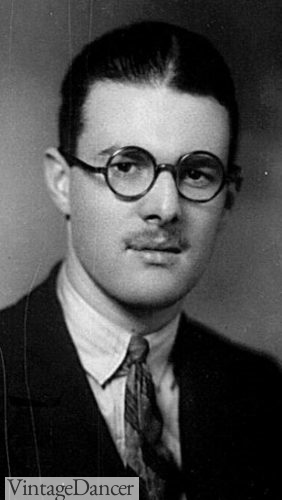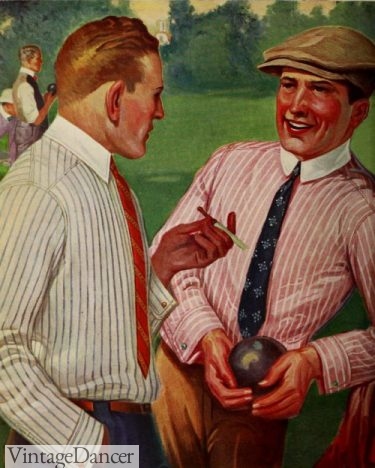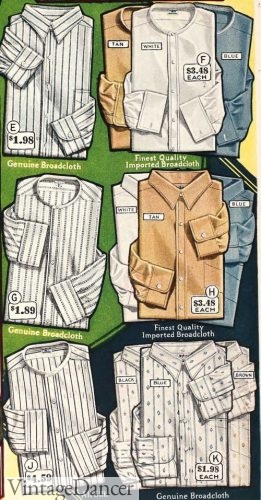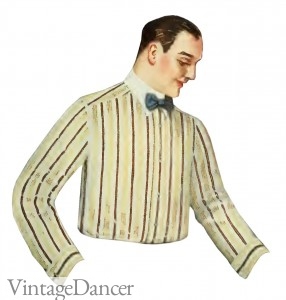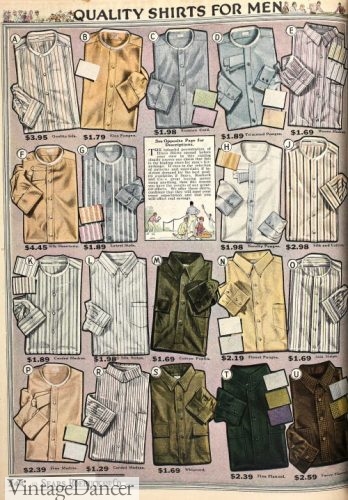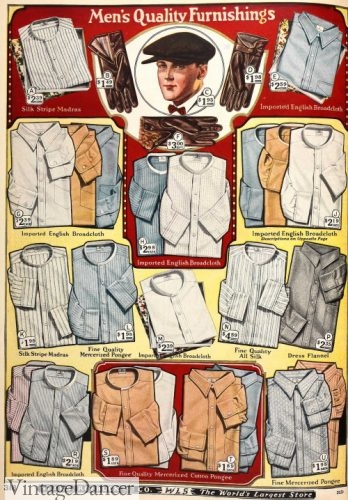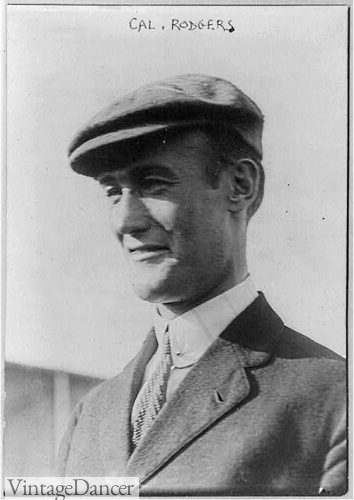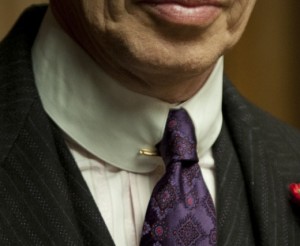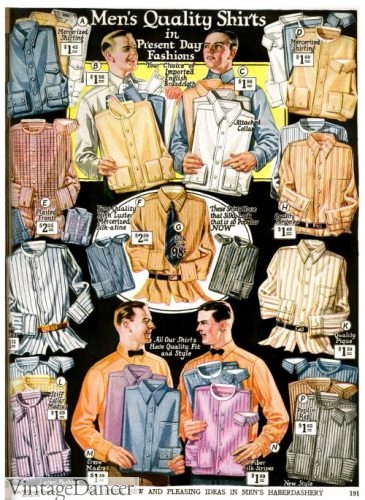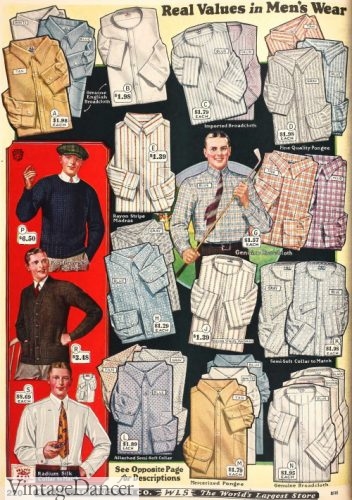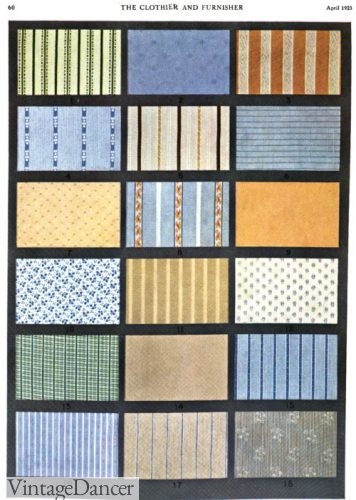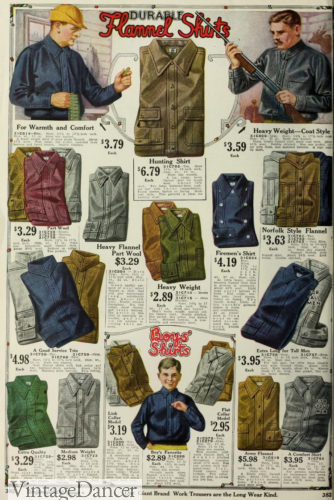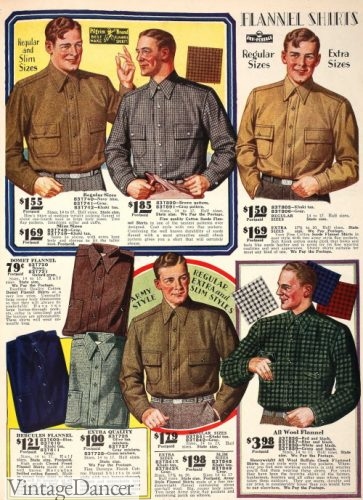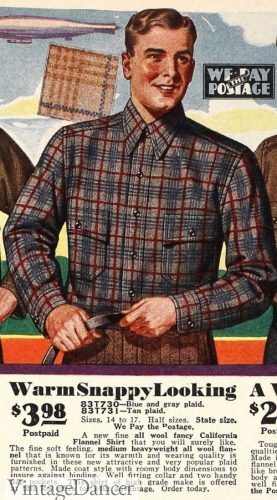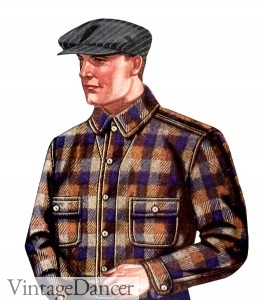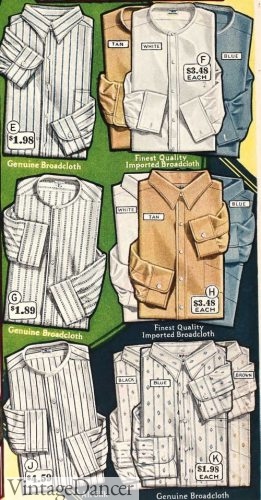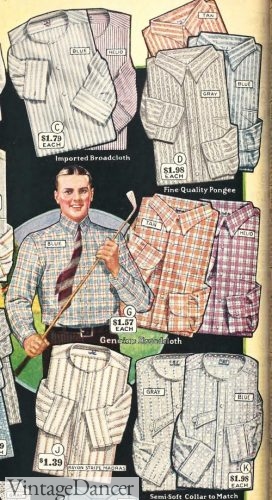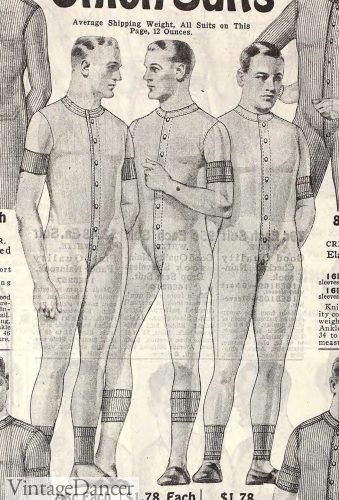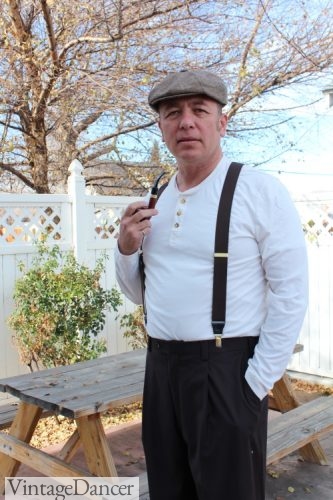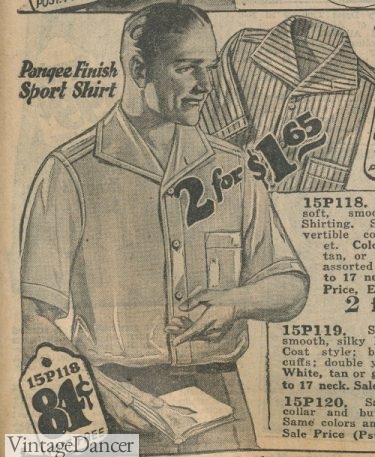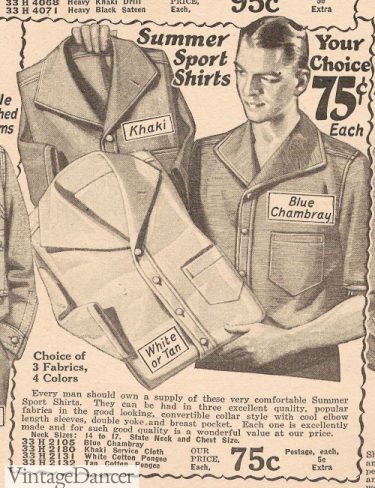The 1920s war on women’s fashion was over the length of dresses, and for the men it was on the softness of shirts. Well, not shirts by themselves, but instead the collars on shirts. For the past few decades, dress shirts and collars were starched stiff so that no wrinkle would ever make a man look sloppy. They contributed to the regal or stuffy air of a proper gentlemen in the Victorian age. 1920s men’s shirts were a rebellion against both plain and rigid clothing.
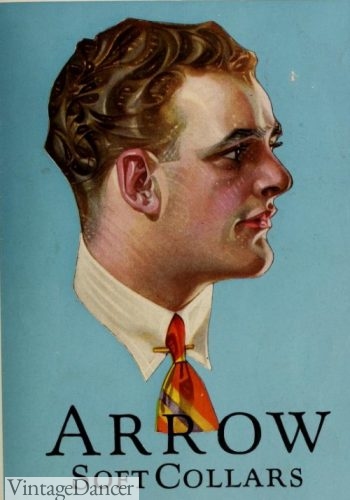
1921 men’s soft collar with collar bar
1920s Shirt Collars
When men were in World War I, they were issued soft shirts with attached collars. For the most part, white collars had been sold separately since the 1830s. Detachable collars saved on laundering since they were the part that needed frequent cleaning and replacement. These new softer shirts and collars were a drastic change from pre-war life. Men became used to the comfort and ease of soft shirts and were reluctant to change back.
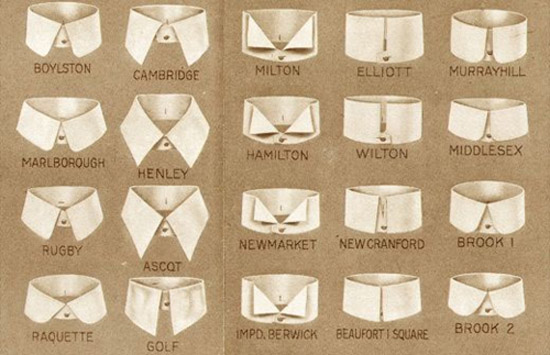
1920 Men’s Stiff Collars- club collars, wingtips, stand collars, fold down collars all were worn in the 1910s
The conservative men did not take the change well. They fought in the media, in club rooms, at social gatherings, in colleges, and court rooms to keep the stiff starched collar in a man’s wardrobe. The war over stiff and soft collars was strongest in Britain, where they thought Americans were the cause of the soft collar craze and everything else casual about menswear. Both countries were divided over this hot fashion issue.
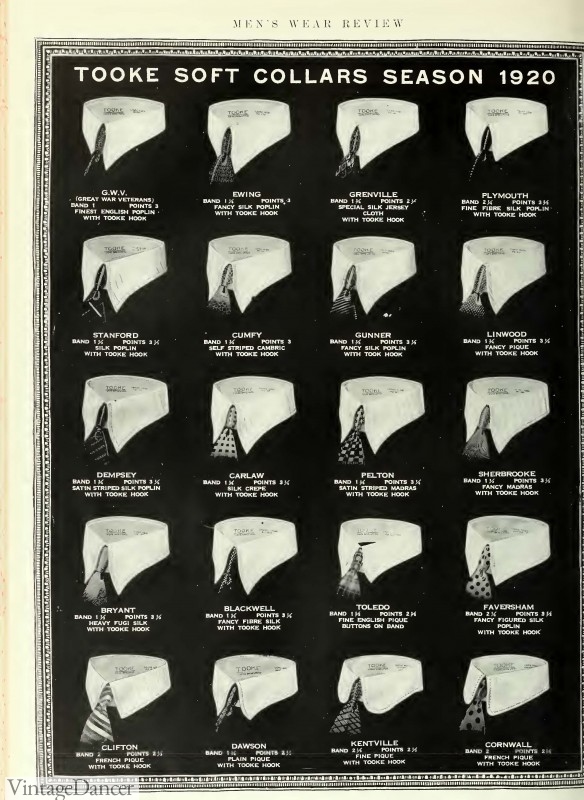
1920 Tooke Detachable Soft Collars- pointed or slightly rounded edges
In the early ’20s, the stuffy detachable white collar was still the norm following fads in the 1900s-1910s. They were always white, always detached, and quite tall (up to 3 inches). Made on celluloid, linen, rubber they could be used several times before washing or replacing. Paper collars became “one use” throw away collars in the late teens and well into the 1920s. The semi-soft collar, a 3 ply woven collar, had the look of a stiff collar but the comfort of a soft collar.
The round edge club collar was the most fashionable from the preceding decade. Fans of Boardwalk Empire will recognize Enoch ‘Nucky’ Thompson, who is almost always wearing one. Thomas Shelby in Peaky Blinders, also wears them in the first few seasons. Hight’s ranged from 3 inches down to less than 2 inches. Some edges were cutaway and others close together, accommodating a variety of tie knots.
- Traditional high and stiff club collar, 1924
- Arthur Edward Waite wears a short club collar, 1921
The soft pointed collar gained favor after 1923 eventually replacing most other collar styles. The pointed collar was still tall and the points could be short or long. By 1928 the Barrymore Collar, later called the Spearpoint collar, with 3 inch very long narrow points was becoming the trendiest shirt collar.
Some soft point collars came in the button-down style which help keep them in place. Collar bars and pins also helped. More on those in a bit.
- 1921 F Scott Fitzgerald wears a long pointed soft collar
- 1922 button down point collar
- 1928 spearpoint collar white shirt with one pocket
- 1929 -1930 Spearpoint Collar Shirts with Two Pockets
The pointed collar shirt remained popular for the rest of the 1920s, although other versions such as the spread collar or fold down collar had their famous moments, too. The popularity of the wide Windsor knot tie required collars to have wide openings, hence the introduction of the spread collar in both round and point styles.
- 1921 spread collar
- Fold down collar with wide opening for a tie
- 1922 narrow spread collar (Rudolph Valentino )
- Short point collar
For evening wear, the collar of choice was still the wingtip collar with bent-over points opening up for the bow tie. These could also be worn during the day with formal morning suits, a very traditional outfit for upper class business men.
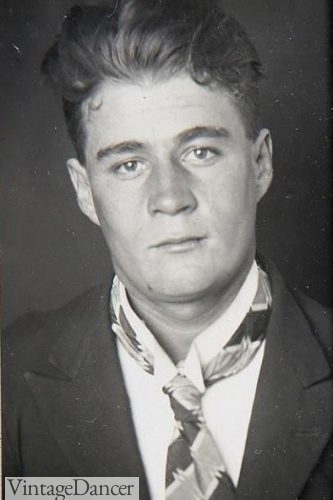
Informal use of a wingtip collar
By the mid 1920s, men’s collars were now mostly attached to the shirts and not all white. First, shirt cuffs started to be made of the same material as the shirt, and later the collars matched, too. The look of a striped shirt and white cuffs and collars was the most common throughout the twenties. The all one-color shirt was seen in casual day shirts, but was too informal for men’s dress shirts until the late ’20s.
- 1921 detachable white collars and striped shirts
- 1927 attached or detachable shirts and collars
The Dress Shirt
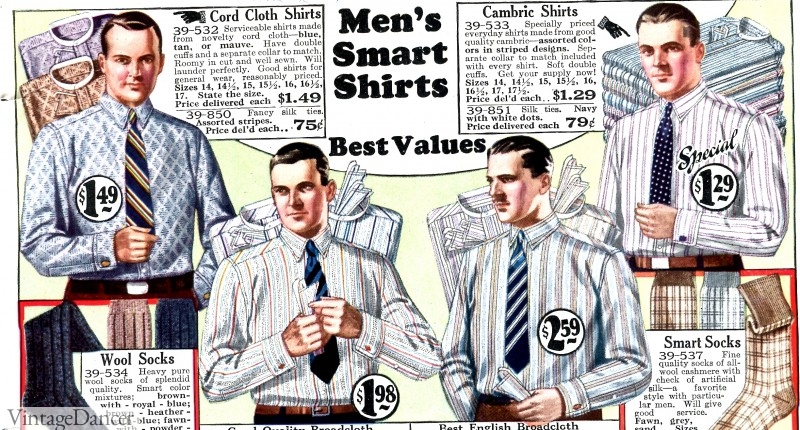
1928 Men’s Dress Shirt
Collar type controversies aside, men’s shirts experienced an explosion of color. Let’s start with dress shirts. In the 1910s, the striped shirt, such as blue, burgundy, or yellow and white vertical stripes, was what every man wore with suits or semi-casual dress. The solid color shirt was only worn by working classes. In the 1920s men could wear patterns or solid colors in bold or light tones.
The trend for stripes continued into the 1920s where various thickness of stripes were mixed with not just one color but multiple colors of stripes. Blue, green and yellow could be seen on one shirt. Pink, yellow and green on another. For dress shirts, the stripes were nearly always against a white background so as to complement whatever suit men chose to wear.
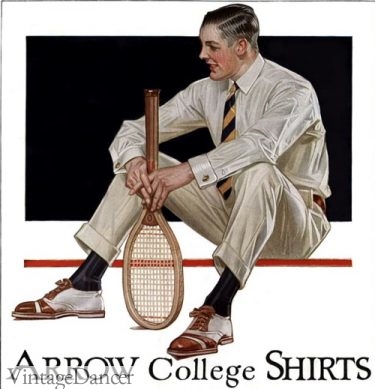
1922 all white shirt for suits or weekend sports
As the decade progressed colors lightened up into pastels or a white body with fine subtle striping. The all white shirt as a staple in most men’s wardrobes who had servants or a laundering service to clean them.
The design of men’s suits vest and jacket came up high on the chest, so no matter what shirt he chose the color was not very visible. But when the suit jacket came off his personality came through in his choice of bold or neutral shirt as well as his tie.
- 1923 light stripes and solid color shirts
- 1925 men’s shirts, pastels and neutral colors
Besides stripes, Chevoit checks, basket weave, light plaids, and even polka dots had their trendy moments. Solid color dress shirts were acceptable towards the mid and late ’20s. Greens and blues were the favorites, although pastel colors like peach, pink, purple, and orange were seen on trendy dressers and as weekend fashions.
The shirt cuffs were almost always French cuffs, also called double cuffs. The cuff folded back onto itself and attached together with a snazzy cuff link.
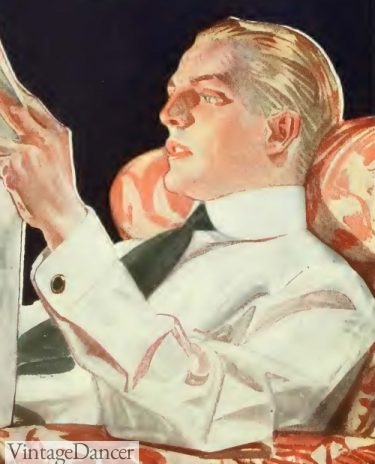
1920 rounded edge club collar with a wide notch opening for a tie, round cuff links
Very fashionable gentlemen also wore a collar bar or collar pin that coordinated with their cuff links. Collar bars held soft white collars in place by clipping to the collar on each side. Collar pins, common in the late ’20s, pinned the collar in place through the eyelet holes in the shirt collar. The tab collar, also common, did the same trick but without the need for bars and pins. The necktie was worn over the collar bar/pin/tab. Read this good article on collar pins for more information.
- Roger Calbreath Wears a Stand Collar with Collar Pin
- See the gold collar bar under the tie?
Fabrics were mostly cottons or linen in summer. Silk was very popular in the 1910s, until the cost of silk import drove the prices too high for the common man in 1920. Thicker, coarser weaves such as cotton broadcloth or madras were favored in the early years with the softer Oxfords and mercerized cotton leading the later years. Soft material that was primarily used for men’s underwear and night shirts became a welcome fabric in men’s dress and casual shirts, too.
- 1925 men’s shirts, very colorful
- 1927 mens shirts, more small patterns
The Great Gatsby had a vast collection of soft colorful shirts:
“He took out a pile of shirts and began throwing them, one by one, before us, shirts of sheer linen and thick silk and fine flannel, which lost their folds as they fell and covered the table in many-colored disarray. While we admired he brought more and the soft rich heap mounted higher — shirts with stripes and scrolls and plaids in coral and apple-green and lavender and faint orange, and monograms of Indian blue. Suddenly, with a strained sound, Daisy bent her head into the shirts and began to cry stormily “They’re such beautiful shirts,” she sobbed, her voice muffled in the thick folds. “It makes me sad because I’ve never seen such — such beautiful shirts before.”
1923 bold patterns and colors for shirts that Jay Gatsby may have worn
1920s Men’s Casual Shirts
While most men wore dress shirts for 90% of their life, the working class, the young men, and the weekend sportsmen wore casual shirts which were long sleeved and collared just like dress shirts. The difference was in the softness of the collars (no starch) and simplicity of design and, color and patterns.
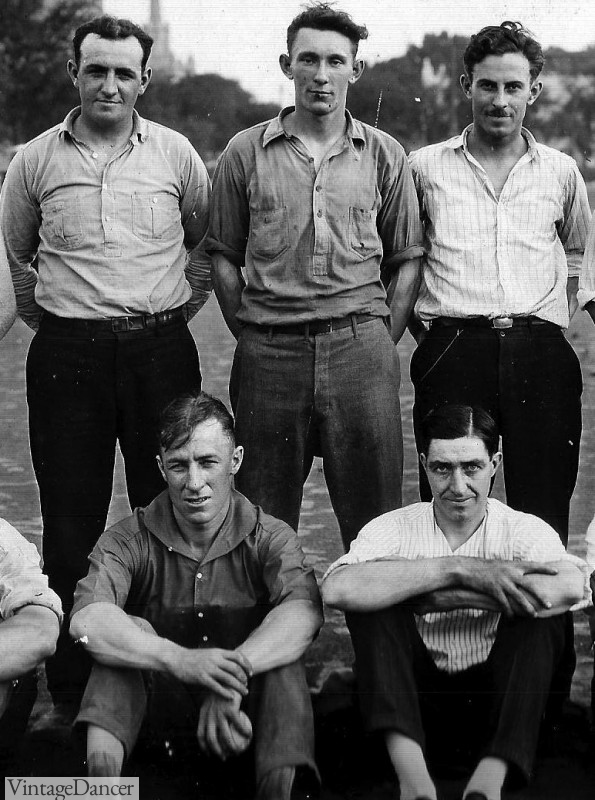
Casual Unbuttoned Shirts
Most casual shirts also had one or two patch pockets on the chest. Dress shirts didn’t need them since they were covered up by vests, suspenders, and suit jackets. The casual shirt pockets, worn uncovered, were perfect for holding reading glasses, some spare change, and cigarettes. Long sleeves were usually rolled up to the elbow and shirt collar buttons undone.
The sport shirt was usually a single color, in a heavier durable fabric such as twill, wool, or flannel for manual work and rugged sports (hunting, hiking, fishing, etc). Cotton, chambrey or madras made up lighter weight summer shirts. Shirts could be “coat style” meaning they buttoned all the way down or they could be pullover where the button plaquette ended at the waistline.
Learn more about men’s 1920s workwear and casual clothes.
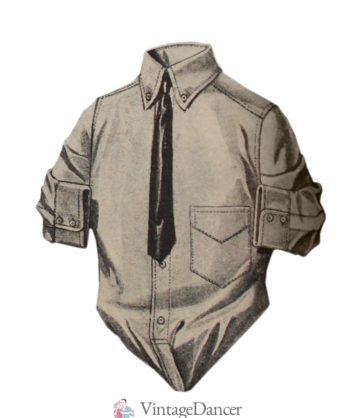
1920’s Men’s Casual Sport Shirt
- 1920 flannel work shirts
- 1929 flannel shirts for work or casual wear
The plaid flannel shirt was exceedingly common in winter. Women loved these comfortable shirts, too, and they quickly became part of their sporty wardrobe as well.
- 1929 plaid flannel work or sport shirt
- 1928 Plaid Work and Sport Shirt
A shirt that was both dressy and casual was the band collar shirt. In its dressy form it came with a matching detachable collar. In casualwear the band collar was sold without a detachable collar or the holes to attach it. Today these may be called grandad collars or mandarin collars.
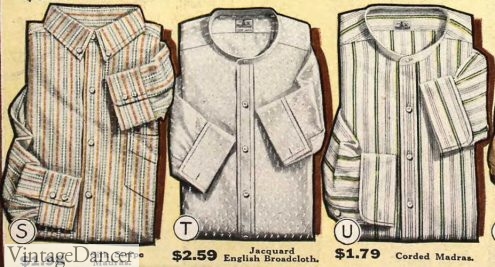
1924 madras sport shirt and band collar shirts
- 1927 summer sport shirts and band collar shirts
- 1927 summer sport shirts
A casual shirt that isn’t a true 1920s shirt is the Henley shirt. It was underwear- one piece union suits– with no collar and buttons down the front. You may see these in movies, TV shows, or under outer shirts in some vintage photographs. Later they would be made into shirts and called Henley’s but that was still several decades away.
- 1921 men’s winter union suits
- Oscar’s casual ’20s outfit with Henley shirt acting as underwear
The short sleeve shirt was just starting to make an appearance in men’s sportswear. The elbow length sleeves allowed freedom to move arms unrestricted. The single chest pocket contently held small items.
The sport collar was unique. It had a large fold out shape (shark collar) with a tab and button that could close it up for dressier needs. It was called a “Convertible collar” for its flexibility. Common colors were white, khaki tan, chambrey blue and narrow vertical stripes of these colors.
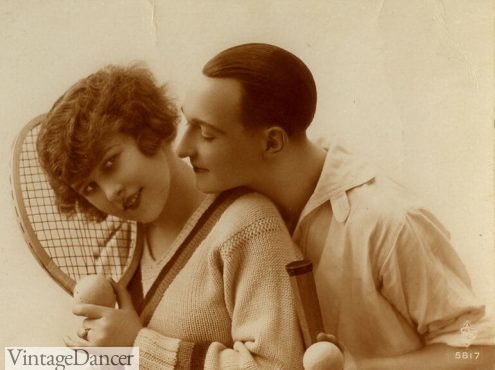
Short sleeve sport shirt
- 1924 summer sport shirt
- 1927 sport shirts, short sleeve
The polo shirt, a short sleeve knit shirt with longer shirt flaps in the back and three buttons up to the collar, was about as casual as you could get. The polo shirt was new to market, and not yet ready for the masses to bare arms. By the 1930s, its the only casual shirt men would wear.
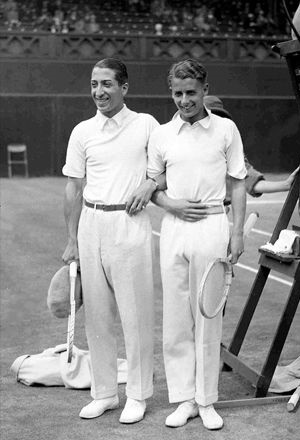
Polo shirts for Tennis players
There were specialty sport shirts for gym / indoor sports. Learn more here.
Buying 1920s Shirts and Collars
Finding good 1920s style shirts can sometimes be challenging. The classic vintage striped shirt with white collar comes in and out of fashion quickly. Last year they were in, this year they are out again. I encourage men to wear colors or stripes, not plain white, shirts. It is not only more fun but will make your outfit look more vintage.
Buy 1920s Style Men’s Shirts
In the AU, try BespokeCollars and in the UK, Classic Wardrobe or Darcy Clothing (same brand as Premier).
Debbie Sessions has been teaching fashion history and helping people dress for vintage themed events since 2009. She has turned a hobby into VintageDancer.com with hundreds of well researched articles and hand picked links to vintage inspired clothing online. She aims to make dressing accurately (or not) an affordable option for all. Oh, and she dances too.
